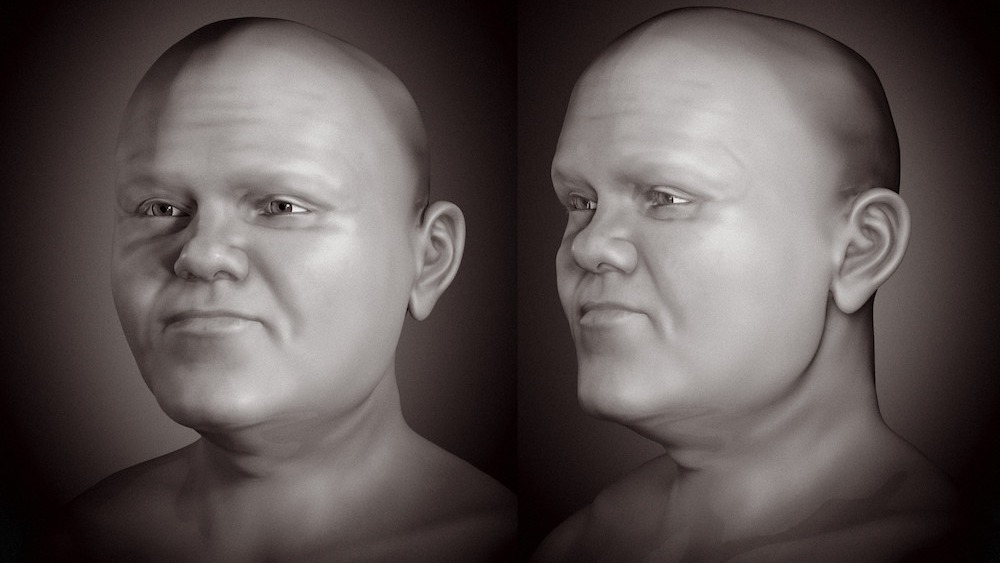See the stunning facial approximation of a medieval man with dwarfism
Researchers used 3D scans of a medieval man's skull to recreate a facial approximation of what he may have looked like when he was alive centuries ago.

In 1990, archaeologists unearthed the skeleton of a man who lived in Poland sometime between the ninth and 11th centuries. After conducting a 3D analysis of his skeletal remains, which were buried in a monastic cemetery alongside 400 other individuals, researchers determined that the medieval man had two forms of dwarfism, a condition so rare that it had never been recorded in a centuries-old skeleton.
Thanks to the 3D scans, the researchers had an idea of what the man's body may have looked like. He had short ribs and "flaring hip bones," which are consistent with achondroplasia, a condition in which someone has short limbs but an average-size torso and a larger-than-average head. He also had "turned-out elbows" and a high arched dental palate, indicating a rare condition known as Léri-Weill dyschondrosteosis. However, the team wasn't sure what the man's face looked like.
Now, a new team of researchers has created a facial approximation of the man, who is known as Ł3/66/90, offering a glimpse of how he may have appeared when alive.
To make the reconstruction, the team used the scans of the individual's skull provided by the researchers who discovered the skeletal remains and imported the scans into a 3D editing program. They then used soft tissue thickness markers measured in a group of living donors and distributed those data points onto the digitized skull, they explained in a study published Aug. 28 in the preprint database bioRxiv.
Related: 35 amazing facial approximations, from Stone Age shamans to King Tut
"In order to know the size of other structures such as the nose, ears, lips and other [facial features], we made a series of projections based on measurements made in CT [computed tomography] scans of living people," study lead author Cícero Moraes, a Brazilian graphics expert, told Live Science in an email. "We also imported the tomography of a living individual, a virtual donor, whose skull structure was adjusted until it became the Ł3/66/90 skull, also modifying the soft tissue."
The researchers created two black-and-white facial approximations. The first is an objective view showing a man with a round face and prominent forehead looking ahead in a neutral position, while the second is a more speculative reconstruction in which the individual has a full head of dark hair and a beard.
Get the world’s most fascinating discoveries delivered straight to your inbox.
One thing that stood out to the researchers was the sheer size of the individual's head.
"The volume of the endocranium (the region that contains the brain) was quite significant, standing out in our sample as the second largest among all," Moraes said.
Having a larger-than-average head is a common characteristic of skeletal dysplasia, a group of conditions that cause abnormal development of bones, joints and cartilage.
Bioarchaeologist Magdalena Matczak, who worked on the initial finding of the man's skeleton but wasn't involved in the new study, noticed several facial features that are indicative of dwarfism.
"The facial approximation highlighted features associated with achondroplasia — a disease the man suffered from — such as a depression of the nasal area and midface hypoplasia [which is when certain facial features aren’t fully developed, such as the upper jaw and eye sockets]," Matczak told Live Science in an email. "Recreating the facial appearance based on 3D models is important because it brings us face-to-face with a person from the past."
Jennifer Nalewicki is former Live Science staff writer and Salt Lake City-based journalist whose work has been featured in The New York Times, Smithsonian Magazine, Scientific American, Popular Mechanics and more. She covers several science topics from planet Earth to paleontology and archaeology to health and culture. Prior to freelancing, Jennifer held an Editor role at Time Inc. Jennifer has a bachelor's degree in Journalism from The University of Texas at Austin.


